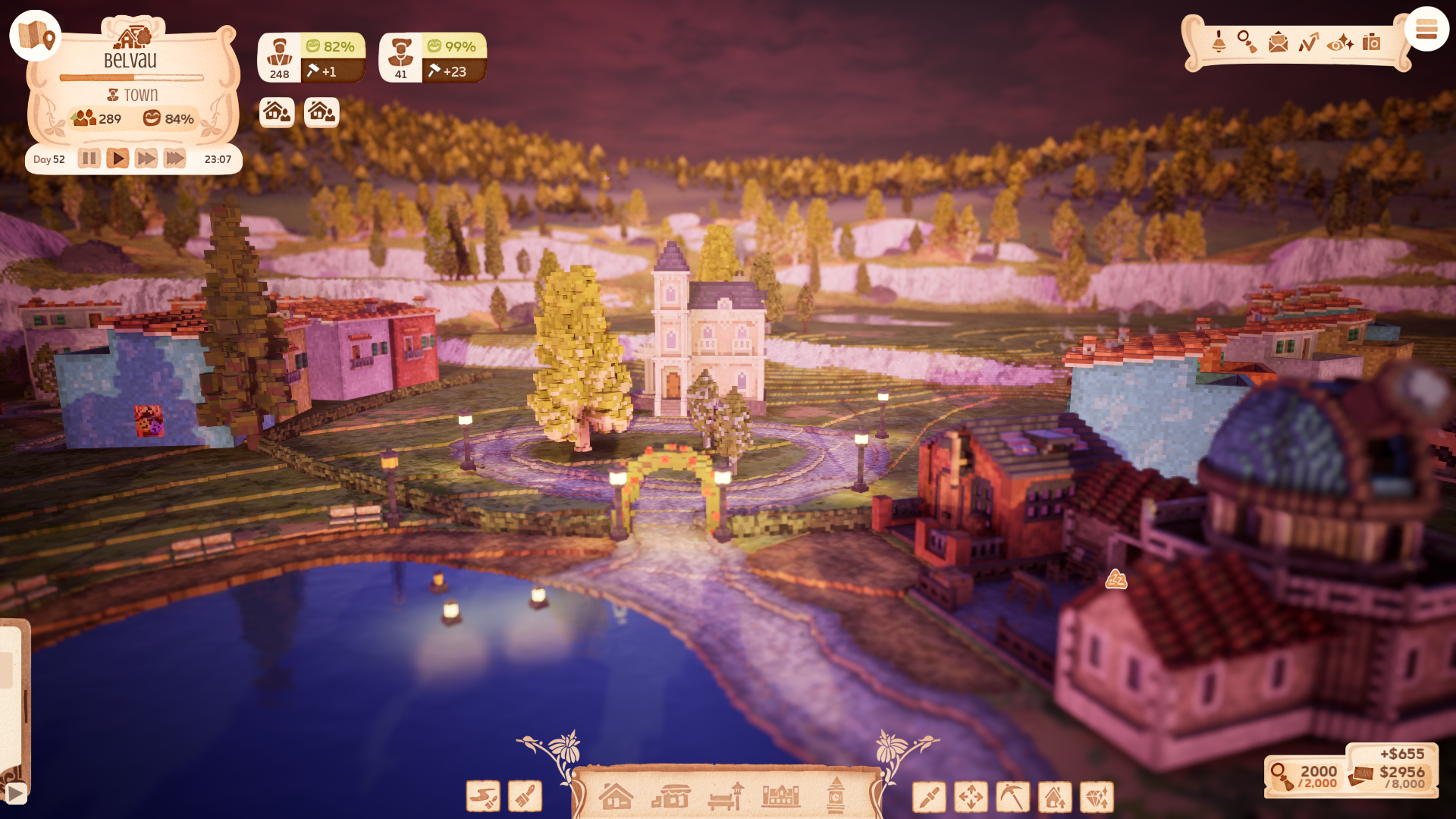
Town to City is a cozy city-builder game developed by Galaxy Grove. You’ll progress from a small, basic habitation with a handful of residents, to a bustling city packed with amenities and details of your own design (and some of your citizens’ requests). To put it simply, this is one of the most enthralling cozy games I’ve ever played, offering just enough depth to stay engaging without becoming overwhelming.
There really isn’t much in the way of plot for Town to City. It’s a Stardew Valley kind of “The place we’re coming from sucks, so we’re doing it again but better” story. Players arrive at a hilly plains area by train, and by that I mean we hover above the area as a god-like entity, free to enact our urbanist agenda as we see fit; after the tutorial, that is. The basic gameplay loop is to build housing to gain residents and make them happy to level up your town, which ultimately grants you more buildings, decorations, and upgrades. And oh, are there decorations. You can add little touches just about everywhere, like flowers, street lamps, benches, trees, tables, and much, much more. They even interact with buildings, so you can put a bunch of hanging lamps or flowers on the wall of a house.

However, there are a few dynamics at play beyond “build more housing.” You see, when the train pulls in with new residents, some will have preferences for what kind of housing they’re given. None of these are complex tasks, mostly just requests like “housing near flowers” or “housing near water,” or sometimes slightly more complex “housing away from neighbors.” It’s a very good way to add engagement and it never feels overbearing. On top of that, your people need access to markets for food via roads, and markets need to be connected to warehouses to stay supplied. Both shops and warehouses need workers as well; the higher the demand, the more workers they’ll need. It’s not a super complex system, but it does keep you planning ahead and putting a little more thought into what goes where.
Keep in mind, the more citizens you have, the more tax money you’ll gain, which can then be spent on buying additional housing, markets, decorations, and more. It’s quite satisfying to go from waiting minutes for enough funds to build a new house to building pretty much whatever you want. It’s also nice that decorations give happiness bonuses to your people, so building a little park isn’t just fun, it’s functional. You need to hit a happiness requirement before you can level up your town, and you also need to maintain a happiness level above 60% to keep getting new arrivals.

Once your town starts to populate, you’ll gain access to the Mayor’s house, which allows you to accept quests from your townsfolk. I personally enjoyed taking little detours from building my town to help the populace with their requests. From putting up posters for an actor’s play, to building a hedge maze, or even carving out an area in the hustle and bustle of your city for a little girl’s book club to meet. If you dislike something you had to build for a quest, you could always take it down after (if you’re a monster), meaning the game isn’t forcing you to change to your citizens' whims. You’ll also get rewards for completing these quests, like money and new decorations. It’s a great way of urging the player to add detail to their growing city, all while helping the people. Speaking of citizens, they’re really endearing folks, each with their own quirks and desires. Despite their faceless voxel-based forms, they’re quite lively and unique, and I really felt for them and their needs during their quests. You’ll typically have a few dialogue options to respond to them with, which is a nice touch. The spritely animations and voice acting (all in French) really bring them to life.
Moving on, another major building you’ll gain access to is the Research Center, which grants players research points over time. There’s an entire research menu that grows as you grow your city. It’s here you can unlock more builds, decorations, and passive upgrades, like increasing the range of your warehouses or adding more stories to your houses. I would suggest keeping these places as productive as possible by increasing their workforce whenever they can take more workers.

Eventually, you’ll unlock more zones, like the farming area, where you start up another town, but with an agricultural industry. Doing this unlocks even more decorations and buildings, like vineyards, wineries, pubs, apiaries, and more. There are also a few minor differences in economic connections, like attaching farm houses to granaries by road, then attaching the granaries to output buildings like wineries. It’s not strict or overly specific, so go wild with the layout. There’s also a new form of research points called farming points, which you’ll gain more of as you increase your agricultural capacity. They fulfill the same purpose as research points, just with a new agricultural unlocks tree. Before moving on to the visuals section, I’d like to note that there’s a third zone, but it’s not available just yet.
Diving into the visuals of Town to City, they’re incredible. The voxel-based graphics are quite detailed and the game’s color palette is earthy and natural. Nothing looks garish or out of place, which really lends itself to the game’s coziness. What really steals the show, though, is the lighting. Town to City features a day and night cycle. By day, you can watch the citizens of your town bring it to life, going about their jobs and enjoying recreational activities. Then the sun sets, and your town is bathed in golden light. When night falls, more subtle warm lights in the form of street lamps dot the area like specks of gold. The stunning visuals are backed up by wholesome yet substantial background music. From mellow airwinds to spritely piano and accordion keys, the music stands out in quality, yet smoothly fits into the background.

My first impressions of Town to City have been nothing but positive. It’s an extremely competent cozy game that wow’d me with its attention to detail, while remaining easily accessible on a broader scale. I can’t wait to see how the game develops in early access. If you’re interested, you can check out Town to City on Steam.
